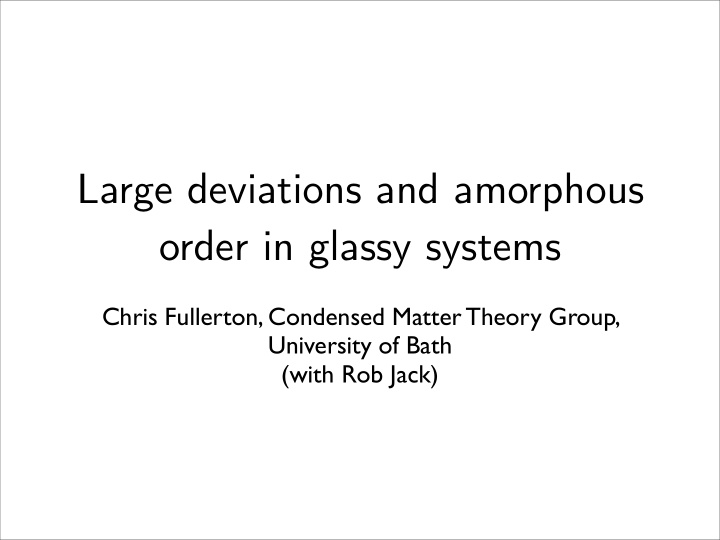



Large deviations and amorphous order in glassy systems Chris Fullerton, Condensed Matter Theory Group, University of Bath (with Rob Jack)
Outline • There is something interesting about inactive configurations • This ‘something’ is likely to do with their inherent structures • The structure can be studied by pinning random particles & studying the behaviour of the remaining mobile particles
Keys, et. al Nat. Phys. 3, 260
� �� ��� � ��� ���� � ��� � ��� ��� Trajectories
Activity & the s- ensemble • Activity, K: t obs N X X r i ( t ) | 2 K [ x ( t )] = � t | ~ r i ( t + � t ) − ~ t =0 i =0 • Generate trajectories using shifting biased by: exp[ − sK ] • Find active/inactive transition
Hedges, Jack, Garrahan, Chandler Science 323
Active vs inactive • Inactive configurations have lower average energy • Can show that this is due to di ff erences in inherent structure: E tot = E IS + E vib • Can this di ff erence be quantified?
Measuring Amorphous order • Sounds like an oxymoron • Measurable using point-to-set correlations
Pinning random particles • Pin particles at random with probability f • Run simulation • Measure correlation functions • Now have 2 types of average to worry about - configurational & over quenched disorder
System Details • Kob-Anderson Liquid (80:20 Lennard-Jones mixture) "✓ � ij ◆ 6 # ◆ 12 ✓ � ij V ( r ij ) = ✏ ij − 2 r ij r ij • Well studied as model glass former • Measure collective overlap, q c (t)
Cells
Cells n i ( t ) = 1 n i ( t ) = 0
Cells n i ( t ) = 1 n i ( t ) = 0 for pinned particles n i ( t ) = 0
The overlap 1 P i h n i ( t ) n i (0) i � q c ( t ) = 1 � N M 1 P A i h n i ( t ) i M M A = 1 − N M
Expectations h n i ( t ) n i (0) i ! h n i ( t ) ih n i (0) i 1 P i h n i ( t ) ih n i (0) i = 1 h n i ( t ) i = N X M 1 P i h n i ( t ) i M M M i q c ( t ) → 0 for f = 0 q c ( t ) → q ∞ for f > 0 c
1 T=0.6 f=0.100 T=0.6 f=0.087 T=0.6 f=0.067 T=0.6 f=0.047 T=0.6 f=0.033 T=0.6 f=0.020 0.8 0.6 q c (t) 0.4 0.2 0 10 -1 10 0 10 1 10 2 10 3 10 4 10 5 10 6 10 7 10 8 time (Monte Carlo steps)
Configurations from inactive trajectories • Not interested in melting of inactive configuration • Freeze fraction f of particles in inactive configuration • Allow all others to return to equilibrium • Only now start to measure q c (t)
1 T=0.6 f=0.100 inactive T=0.6 f=0.087 inactive T=0.6 f=0.067 inactive T=0.6 f=0.047 inactive T=0.6 f=0.033 inactive T=0.6 f=0.020 inactive 0.8 0.6 q c (t) 0.4 0.2 0 10 -1 10 0 10 1 10 2 10 3 10 4 10 5 10 6 10 7 10 8 time (Monte Carlo steps)
1 T=0.6 f=0.100 T=0.6 f=0.100 inactive T=0.6 f=0.087 T=0.6 f=0.087 inactive T=0.6 f=0.067 T=0.6 f=0.067 inactive 0.8 T=0.6 f=0.047 T=0.6 f=0.047 inactive T=0.6 f=0.033 T=0.6 f=0.033 inactive T=0.6 f=0.020 T=0.6 f=0.020 inactive 0.6 q c (t) 0.4 0.2 0 10 -1 10 0 10 1 10 2 10 3 10 4 10 5 10 6 10 7 10 8 time (Monte Carlo steps)
0.14 Frozen particles from equilibrium Frozen particles from inactive 0.12 0.1 0.08 � q c 0.06 0.04 0.02 0 0 0.01 0.02 0.03 0.04 0.05 0.06 0.07 f
Conclusions • There is something interesting about the structure of inactive configurations • We can measure this using point-to-set correlations (pinning particles) • We don’t have to pin very many particles for this di ff erence to be apparent - this is pretty surprising!
Recommend
More recommend